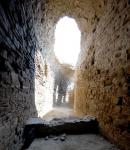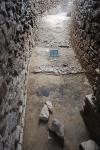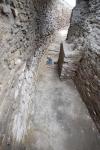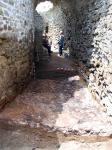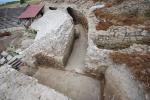Summary (English)
The season of 2015 at the theatre started with excavation of the higher segments in the eastern half of the central circular corridor to the level made of green grinded bedrock, after what, this corridor and the eastern radial corridor were excavated by following of every context at the whole area. Five levels of use with their repairs and six layers between them were documented as part of the Late Antique deposits. The quantity of archaeological material includes animal bones, pottery and bronze coins that date from the end of the 4th to the beginning of the 6th century. A grave with a child inhumation was discovered at the last level of use documented in 2014.
The removal of the Late Antique deposits was followed by excavation of five levels of use belonging to the period when the theatre was active. Тhe same levels were documented in the circular and the radial corridor. The highest level of use was formed by a massive layer of grinded green bedrock with clay structure. The layer was 0.4 to 1.2 metres thick, depending on the excavated segment of the corridors. The surface of the layer was the last level of use of the active theatre. It is very likely that the repairs of the vault and circular wall III in the eastern end of the circular corridor were done in the 4th century, as suggested by the coin of Constantius II, discovered in the mortar of the preserved remains of the vault.
The second lowest documented level of use has crumbled mortar on the surface along the circular wall III and it can be roughly dated in the 2-3 centuries, due to the discovered coins of Antoninus Pius and Marcus Aurelius (as Caesar) in the layers above. It is interesting to note, that right under the surface of this level, there were few small fragments of mortar with traces of red colour which have fallen off from the face of circular wall III. Also, it is important to note that the layer below the level contains large quantity of white and pink chips, pointing to stone carving activities. The same layer is documented in other parts of the building as well.
The lowest documented level of use bears the remains of lime, clay bricks and stones, indicating construction activities. A series of trenches were dug from this level, but they remain unexcavated and without known purpose at the end of the season 2015.
The analysis of the circular walls, exposed to a height of around 5 metres, reveals two phases of construction and one phase of repair. The first phase includes three manners of arrangement of the stones as the result of the work of different masons, probably in a longer period of time. During this phase, the masons used red painted lines as markers. The second phase usually starts right above the highest red line and it has unified manner of stone arrangement that includes almost rectangular sandstone. The work in this phase begun some period after the activities of the first phase had stopped and it was probably done by different masons in a relatively shorter period. The repair of the circular wall III is the last stage in the history of the corridor from the period when the theatre was active. The eastern half of the excavated area of the circular corridor was covered by a restored vault which happened after the wall was repaired. The repair was done by large sandstone blocks in the shape of irregular squares.
Director
- Silvana Blazevska - National Institution Stobi
Team
- Dimitar Nikolovski - NI Stobi
- Rade Atanasov
- Goce Pavlovski - NI Stobi
Research Body
- National Institution Stobi
Funding Body
- Ministry of Culture of Republic of Macedonia





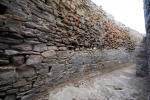
![Download [PDF]](/excavation/skins/fasti/images/results/download_sml.png)
